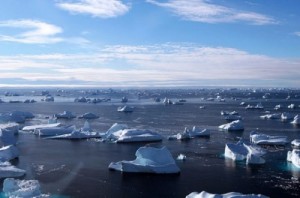While many of us in the continental U.S. are enjoying record-breaking temperatures this March, EU foreign policy chief Catherine Ashton probably needed her down coat as she embarked on her new mission: laying the groundwork for a common EU policy on the Arctic. Traveling near the North Pole earlier this month, Ashton made a case for the EU to receive permanent observer status on the Arctic Council, current members of which are Canada, Russia, Denmark (through Greenland), Finland, Iceland, Norway, Sweden, and the U.S.
The EU’s increased interest in the region is hardly surprising considering the fact that the region is known to hold vast mineral resources, among them an estimated 13 percent of the worlds undiscovered oil reserves, and 30 percent of undiscovered gas reserves.
As the global race for resources has heated up, so has the geopolitical tussle over the Arctic’s mineral riches:
- In 2004, Denmark extended a bid on its geological claim linking the North Pole and Greenland via the Lomonosov Ridge.
- The summer of 2007 saw a number of movements, including a Russian minisub expedition planting a Russian flag beneath the North Pole, and Canada announcing plans to build two new Arctic military bases and a deep-sea port in the region.
- While Russia and Norway signed a deal over who owns what in the Barents Sea, a piece in the Guardian from July 2011 outlined ongoing territorial tussles between the U.S, Canada, Russia, Denmark and Norway.
- The Toronto Star warned in December 2011 that Russia may be ready to embrace “a new Cold War” over the Arctic, which it sees as its strategic future.
- In January of 2012, the Arctic race for mineral riches got a new dimension when China threw its hat into the ring, with Denmark having decided to serve as “the key gateway for Beijing’s commercial and strategic entrée into the Arctic.”
Today, Alaska’s state motto “North to the Future” sounds more timely than ever. Fortunate to have a claim to the Arctic’s riches via “Seward’s Folly”, the U.S. would be well-advised to harness Alaska’s significant resource potential, as envisioned by Gov. Sean Parnell – boosting job creation and reducing our needless over-reliance on foreign mineral resources in the process.





